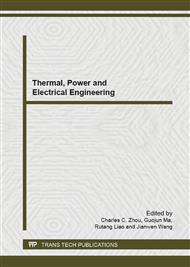p.148
p.152
p.156
p.161
p.165
p.172
p.176
p.182
p.186
Operation Characteristic of a Mechanical Vapor Recompression Heat Pump Driven by a Centrifugal Fan
Abstract:
A mechanical vapor recompression heat pump driven by a centrifugal fan is designed together with falling-film evaporation. Based on theoretical analysis, experimental research is applied to study the fan type of MVR. Choosing water as the experimental medium, the operation characteristic of MVR applied to low evaporation is examined. Practically, the pressure difference of the unit is likely to keep stable while its evaporation pressure goes up. After the system performance is tested and analyzed, it shows that the total evaporation water and total input energy increase as its evaporation pressure grows. Further, some calculation is done and the result indicates that its SMER and COP decrease while the evaporation pressure rises. The reason of this phenomenon is: the leakage loss of the fan inside goes up and its displacement efficiency reduces as the evaporation temperature and pressure is high; finally, it brings forth the drop of the systems adiabatic efficiency. Finally, the trend of average input work for compressed vapor is compared in three different terms. The trend of average input work by calculation is the same as that in theory; that is to say, both of them descend when the evaporation pressure ascends. Because of displacement efficiency, the trend of average input work by measure is different from that in theory; that is to say, the average input work by measure grows slightly when the evaporation pressure goes up.
Info:
Periodical:
Pages:
165-171
Citation:
Online since:
August 2013
Authors:
Price:
Сopyright:
© 2013 Trans Tech Publications Ltd. All Rights Reserved
Share:
Citation:


